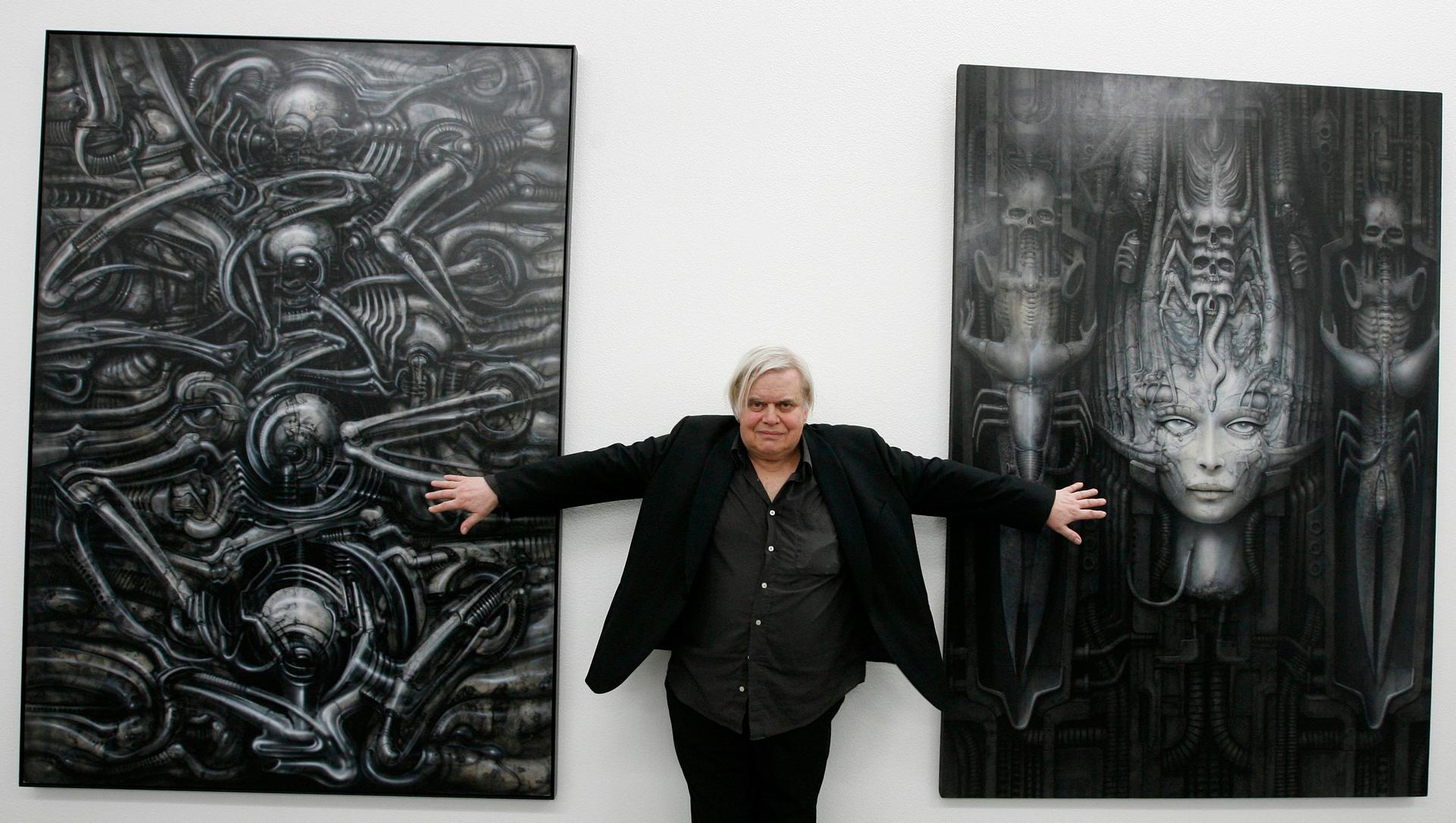The life and work of surrealist genius, H.R.Giger
H.R. Giger poses with two of his works at his museum in Chur, Switzerland.
It's a grim day for fans of dark, surreal art. The godfather of the form, H.R.Giger, died Monday after a fall at age 74.
The Swiss artist christened his style "biomechanical." Think "Alien": you know the face-sucking, body-bursting kind. H.R. Giger was the artist and designer for the monster and many of the sets in Ridley Scott's 1979 classic with Sigourney Weaver and the ill-fated John Hurt.
"His designs," says Roger Luckhurst, "completely transformed the idea of the monster in gothic science fiction films." Luckhurst is writing a book on "Alien" for the British Film Institute.
"Beforehand, it had always been a rather laughable man in a rubber suit. As soon as Ridley Scott saw H.R.Giger's paintings, he realized he'd got the monster that he really wanted, and was completely astounded. Of course, it has completely changed the conception of what scares you in science fiction monster films now."
But H.R. Giger was much more than the creator of a movie monster, even if it did get him an Oscar. His art inspired a generation of talented, creative monsters: writers like William Gibson and Neil Gaiman; filmmakers like Guillermo del Toro; and swarms of hoody-clad game designers.
By the way, the name is pronounced Ghee-gher, even though he's best known in the US as Guy-gher.
His own influences? One big influence was the cult horror fiction writer HP Lovecraft. In fact, Giger's artwork helped revive interest in Lovecraft’s body of work.
But Luckhurst says H.R. Giger reached inside for inspiration, as well.
"He always talked about dredging up his images from his subconscious … incredibly-sexualized, but also terrifying images of machines combined with bodies, usually women’s bodies. He talked about how all these ideas came from traumatic images or memories from his nightmares.”
Giger once said that his paintings "seem to make the strongest impression on people who are, well, crazy."
Luckhurst says despite his popularity, Giger always felt that he never got the recognition he deserved. And yet he lived in extravagant gothic splendor in Switzerland. He bought a castle to house his own museum.
“He was an extraordinary and very eccentric figure; a wonderful descendant from that Dali surrealism," Luckhurst says. "So he’s not really considered — in the fine art world — a ‘proper’ artist. A bit like Salvador Dali. But in the popular culture, he’s exactly what people want an artist to be. Very eccentric, always dressed in black leather; always behaving in an odd and eccentric way; always muttering darkly about death, sex and despair. What more do you want?”
It's a grim day for fans of dark, surreal art. The godfather of the form, H.R.Giger, died Monday after a fall at age 74.
The Swiss artist christened his style "biomechanical." Think "Alien": you know the face-sucking, body-bursting kind. H.R. Giger was the artist and designer for the monster and many of the sets in Ridley Scott's 1979 classic with Sigourney Weaver and the ill-fated John Hurt.
"His designs," says Roger Luckhurst, "completely transformed the idea of the monster in gothic science fiction films." Luckhurst is writing a book on "Alien" for the British Film Institute.
"Beforehand, it had always been a rather laughable man in a rubber suit. As soon as Ridley Scott saw H.R.Giger's paintings, he realized he'd got the monster that he really wanted, and was completely astounded. Of course, it has completely changed the conception of what scares you in science fiction monster films now."
But H.R. Giger was much more than the creator of a movie monster, even if it did get him an Oscar. His art inspired a generation of talented, creative monsters: writers like William Gibson and Neil Gaiman; filmmakers like Guillermo del Toro; and swarms of hoody-clad game designers.
By the way, the name is pronounced Ghee-gher, even though he's best known in the US as Guy-gher.
His own influences? One big influence was the cult horror fiction writer HP Lovecraft. In fact, Giger's artwork helped revive interest in Lovecraft’s body of work.
But Luckhurst says H.R. Giger reached inside for inspiration, as well.
"He always talked about dredging up his images from his subconscious … incredibly-sexualized, but also terrifying images of machines combined with bodies, usually women’s bodies. He talked about how all these ideas came from traumatic images or memories from his nightmares.”
Giger once said that his paintings "seem to make the strongest impression on people who are, well, crazy."
Luckhurst says despite his popularity, Giger always felt that he never got the recognition he deserved. And yet he lived in extravagant gothic splendor in Switzerland. He bought a castle to house his own museum.
“He was an extraordinary and very eccentric figure; a wonderful descendant from that Dali surrealism," Luckhurst says. "So he’s not really considered — in the fine art world — a ‘proper’ artist. A bit like Salvador Dali. But in the popular culture, he’s exactly what people want an artist to be. Very eccentric, always dressed in black leather; always behaving in an odd and eccentric way; always muttering darkly about death, sex and despair. What more do you want?”
